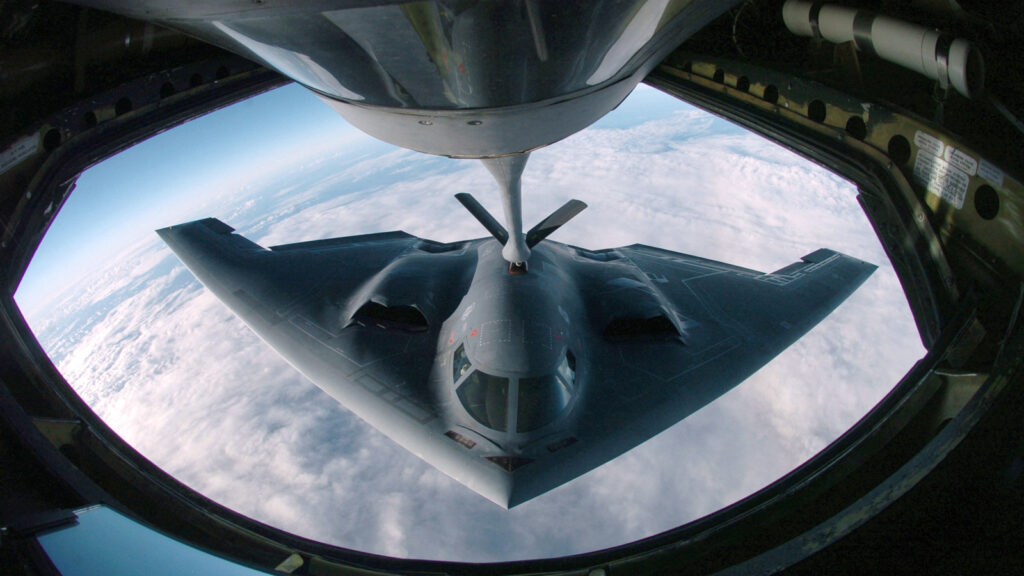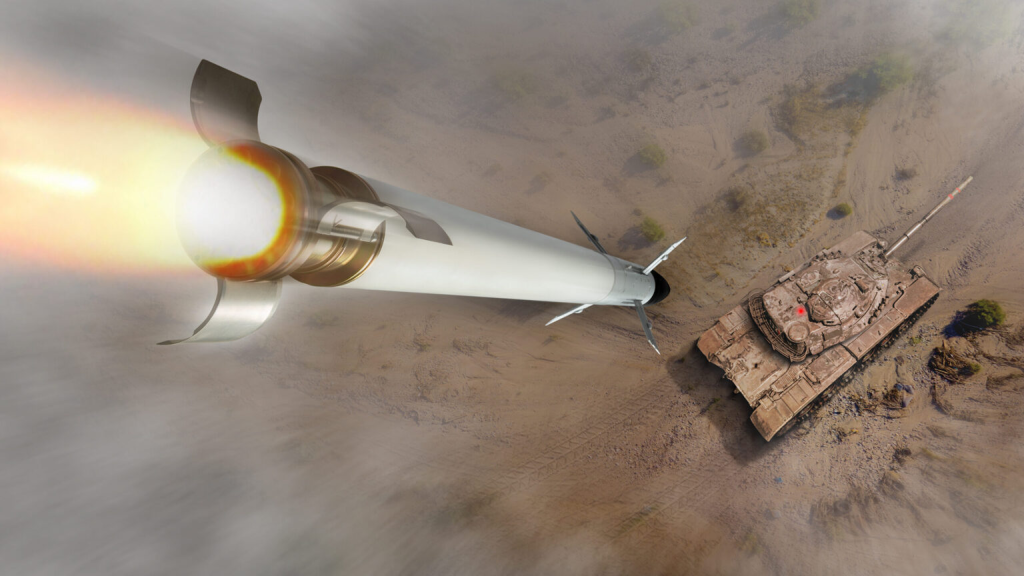
(FILES) This 4 April, 2005 Department of Defense handout image shows a B-2 Spirit multi-role bomber conducting air refueling operations with a KC-135 Stratotanker over the Pacific Ocen. US stealth bombers were flying on June 21, 2025 across the Pacific Ocean, according to tracking data and media reports, fueling speculation over their intended mission as President Donald Trump considers joining Israel’s attack on Iranian nuclear sites. Multiple B-2 bomber aircraft left a base in the central United States overnight and were later tracked flying off the California coast along with aerial refueling jets, The New York Times and specialist plane tracking sites reported. (Photo by US Department of Defense / AFP) / RESTRICTED TO EDITORIAL USE – MANDATORY CREDIT “AFP PHOTO / US DEPARTMENT OF DEFENSE”- NO MARKETING NO ADVERTISING CAMPAIGNS – DISTRIBUTED AS A SERVICE TO CLIENTS
The B-2 Spirit is one of the most sophisticated and high-tech aircraft ever built by the United States. military arsenal, is capable of delivering devastating strikes against heavily fortified underground targets. Its earth-penetrating “bunker-buster” bomb combines stealth technology, precision guidance, and overwhelming kinetic force to destroy enemy installations deep below the surface.
Recent conflicts in the Middle East have brought renewed attention to this fearsome weapon, highlighting its role in modern warfare.
1. The Mechanics of the Bunker-Buster Bomb

Gravity-Powered Destruction
Unlike missiles, the bunker-busting bomb dropped by the B-2 doesn’t use an engine—it simply falls using the force of gravity. Instead, it is dropped from an altitude of 12 kilometers (40,000 feet), accelerating purely due to gravity. As it falls, it reaches supersonic speeds, turning its massive weight into kinetic energy capable of smashing through reinforced concrete and rock.
Hardened Casing and Deep Penetration
The bomb’s tungsten or steel-alloy casing is designed to withstand extreme impact forces, allowing it to burrow up to 60 meters (200 feet) underground before detonating. This makes it capable of hitting well-protected targets hidden deep underground, like:
- Nuclear facilities
- Underground command bunkers
- Weapons storage sites
- Tunnel networks
Delayed Fuse for Maximum Impact
A programmable fuse delays detonation until the bomb has penetrated its target. Once deep underground, it unleashes 2,400 kg (5,300 lbs) of high explosives, collapsing structures from within and ensuring total destruction.
2. Precision Guidance: Hitting the Target Every Time

Satellite and Inertial Navigation
The bomb uses GPS and inertial guidance systems to adjust its trajectory mid-flight. Even if enemies attempt GPS jamming, backup systems ensure it stays on course.
Movable Tail Fins for Mid-Air Adjustments
Small control fins allow the bomb to steer itself, correcting for wind resistance or last-minute target shifts. This makes it far more accurate than traditional unguided bombs.
Ability to Strike in Denied Airspace
Since the B-2 bomber is nearly invisible to radar, it can deploy these bombs deep inside enemy territory without detection. By the time defenses react, it’s often too late.
3. The Role of the B-2 Stealth Bomber

Radar-Evading Design
The B-2’s flying-wing shape and special coatings absorb and deflect radar waves, making it extremely difficult to detect. This allows it to penetrate advanced air defense systems that would stop conventional bombers.
Long-Range Strike Capability
With a 10,000+ km (6,200+ mi) range and mid-air refueling, the B-2 can strike targets anywhere in the world within 24 hours.
Payload Flexibility
In addition to bunker-busters, the B-2 can carry:
- Nuclear weapons
- Cruise missiles
- Conventional bombs
This versatility makes it a key asset in both conventional and strategic warfare.
4. Psychological and Strategic Impact

The “Unreachable” Target Myth
Many nations bury critical facilities underground, believing they’re safe from airstrikes. The B-2’s bunker-buster shatters that illusion, forcing enemies to rethink their defenses.
Deterrence and Dominance
The mere presence of this capability deters adversaries from building underground installations, knowing they can be destroyed.
Historical Use in Conflicts
While exact details are classified, the B-2 and similar weapons have been used in:
- The Iraq War (2003) – Targeting underground command centers
- Potential strikes in Iran and North Korea – Against nuclear facilities
- Ongoing Middle East operations – Against terrorist tunnel networks
5. Future of Bunker-Busting Weapons

Hypersonic and AI-Guided Upgrades
Future versions may incorporate:
- Hypersonic speeds for faster penetration
- AI-powered targeting for smarter evasion of defenses
- Enhanced stealth coatings to avoid next-gen radar
Drone-Deployed Bunker Busters
Unmanned stealth bombers could one day deliver these bombs, reducing risk to pilots.
Space-Based Targeting Systems
Satellites with real-time ground-penetrating radar could improve strike accuracy even further.
6. Technical Specifications and Capabilities

Weight and Dimensions
The B-2’s primary bunker-buster weapon, the GBU-57A/B Massive Ordnance Penetrator (MOP), boasts impressive physical characteristics:
- Length: 6.2 meters (20.3 feet)
- Weight: 13,600 kg (30,000 lbs)
- Diameter: 80 cm (31.5 inches)
These dimensions allow it to carry a massive explosive payload while maintaining aerodynamic efficiency during its descent.
Explosive Composition
The bomb’s warhead contains:
- 2,400 kg (5,300 lbs) of AFX-757 explosive
- High-performance penetrating casing made of nickel-cobalt steel alloy
- Programmable smart fuse with multiple delay settings
Penetration Capabilities
Comparative penetration data:
| Material | Penetration Depth |
|---|---|
| Reinforced concrete | 60+ meters |
| Hardened rock | 40 meters |
| Compacted earth | 80 meters |
| Steel-reinforced bunkers | 8+ meters |
7. Operational Deployment Process

Mission Planning Phase
- Target identification via satellite and intelligence sources
- Route optimization to avoid enemy air defenses
- Weather analysis for optimal drop conditions
- Bomb programming with precise coordinates and detonation parameters
In-Flight Operations
- Approach: B-2 maintains 50,000 ft altitude in stealth mode
- Release: Bomb deploys at precise GPS coordinates
- Descent: Weapon reaches Mach 1.2 terminal velocity
- Impact: Kinetic energy creates initial penetration
- Detonation: Delayed explosion ensures maximum damage
8. Comparative Analysis with Other Bunker Busters

GBU-57 MOP vs. Previous Generation Weapons
| Feature | GBU-57 (B-2) | GBU-28 (F-15E) | BLU-109 |
|---|---|---|---|
| Weight | 13,600 kg | 2,300 kg | 900 kg |
| Penetration | 60m+ | 6m | 3m |
| Carrier Aircraft | B-2 only | Multiple | Multiple |
| Guidance | GPS/INS | Laser/GPS | Unguided |
| Explosive | 2,400 kg | 300 kg | 240 kg |
Advantages Over Competing Systems
- Deeper penetration than any conventional bomb
- Greater explosive yield for complete destruction
- Stealth delivery eliminates warning time
- All-weather capability with GPS guidance
9. Cost and Maintenance Factors

Program Expenses
- Unit cost per bomb: $3.7 million
- B-2 operational cost: $135,000 per flight hour
- Total program investment: $1.2 billion (development and production)
Maintenance Requirements
- Specialized storage for explosive components
- Climate-controlled facilities for guidance systems
- Pre-flight checks: 18-hour preparation process
- Post-mission maintenance: 72-hour turnaround time
10. Limitations and Vulnerabilities

Technical Challenges
- Limited carrier capability (only B-2 can deploy)
- Massive size restricts quantity per mission
- Precision requires stable GPS signals
- Deep targets may require multiple strikes
Potential Countermeasures
- Advanced early warning systems
- Underground decoy facilities
- GPS jamming technologies
- Deep-buried structures beyond 100m


